| Maintenance Service Interval | Maintenance Procedure |
|---|---|
| After each use |
|
Introduction
This kit is designed to aid in the mixing of chemicals in preparation for turf spray applications on well-maintained lawns in parks, golf courses, sports fields, and on commercial grounds. It is a dedicated attachment for a turf spray application vehicle and is intended to be used by professional, hired operators in commercial applications. Using this product for purposes other than its intended use could prove dangerous to you and bystanders.
Read this information carefully to learn how to operate and maintain your product properly and to avoid injury and product damage. You are responsible for operating the product properly and safely.
Visit www.Toro.com for product safety and operation training materials, accessory information, help finding a dealer, or to register your product.
Whenever you need service, genuine Toro parts, or additional information, contact an Authorized Service Dealer or Toro Customer Service and have the model and serial numbers of your product ready. Figure 1 identifies the location of the model and serial numbers on the product. Write the numbers in the space provided.
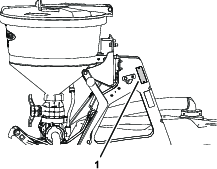
This manual identifies potential hazards and has safety messages identified by the safety-alert symbol (Figure 2), which signals a hazard that may cause serious injury or death if you do not follow the recommended precautions.

This manual uses 2 words to highlight information. Important calls attention to special mechanical information and Note emphasizes general information worthy of special attention.
This product complies with all relevant European directives; for details, please see the separate product specific Declaration of Conformity (DOC) sheet.
Warning
CALIFORNIA
Proposition 65 Warning
Use of this product may cause exposure to chemicals known to the State of California to cause cancer, birth defects, or other reproductive harm.
Safety
Warning
Chemical substances used in the spray system may be hazardous and toxic to you, bystanders, animals, plants, soil, or other property.
-
Carefully read and follow the chemical warning labels and Safety Data Sheets (SDS) for all chemicals used and protect yourself according to the chemical manufacturer's recommendations. For example, use appropriate Personal Protective Equipment (PPE) including face and eye protection, gloves, or other equipment to guard against personal contact with the chemical.
-
Keep in mind that there may be more than one chemical used, and information on each chemical should be assessed.
-
Refuse to operate or work on the sprayer if this information is not available!
-
Before working on a spray system, make sure that the system has been triple rinsed and neutralized according to the recommendations of the chemical manufacturer(s).
-
Verify that there is an adequate supply of clean water and soap nearby, and immediately wash off any chemicals that contact you.
Shut off the machine, remove the key (if equipped), and wait for all movement to stop before you leave the operator’s position. Allow the machine to cool before adjusting, servicing, cleaning, or storing it.
Improperly using or maintaining this machine can result in injury.
To reduce the potential for injury, comply with these safety instructions
and always pay attention to the safety-alert symbol  , which means
Caution, Warning, or Danger—personal safety instruction. Failure
to comply with these instructions may result in personal injury or
death.
, which means
Caution, Warning, or Danger—personal safety instruction. Failure
to comply with these instructions may result in personal injury or
death.
Safety and Instructional Decals
 |
Safety decals and instructions are easily visible to the operator and are located near any area of potential danger. Replace any decal that is damaged or missing. |



Setup
Note: Determine the left and right sides of the machine from the normal operating position.
Preparing to Install the Kit
-
Clean the sprayer; refer to Cleaning the Sprayer in the Operator’s Manual for the machine.
-
Park the machine on a level surface, engage the parking brake, shut off the engine, remove the key, and wait for all movement to stop before you leave the operator’s position; refer to the Operator’s Manual for your vehicle.
Assembling the Frame
Parts needed for this procedure:
| Support frame assembly | 1 |
| Flange locknut (3/8 inch) | 2 |
| Back-plate assembly | 1 |
| Cradle arm, right | 1 |
| Cradle arm, left | 1 |
| Bushing, small | 2 |
| Pivot pin | 2 |
| Jam nut (3/8 inch) | 2 |
| Handle | 2 |
| Bolt (3/8 x 1-1/4 inches) | 2 |
| Set screw | 2 |
| Hairpin | 2 |
| Flat washer | 2 |
| Thick square spacer | 2 |
| Thin square spacer | 2 |
| Carriage bolt (3/8 x 1-1/2 inch) | 2 |
Installing the Support Frame to the Tank
-
Remove the fasteners securing the rear tank straps at the top of the tank.
Note: Retain all parts.
-
Install 2 carriage bolts (3/8 x 1-1/2 inch) to the inboard holes on the left side of the rear tank strap.
-
Install the tank strap fasteners removed previously to secure the straps to the tank.
Note: Make sure that the strap is secure to the tank. Do not overtighten the strap.
-
Mount 1 thick square spacer and 1 thin square spacer over the 2 previously installed carriage bolts (Figure 3).
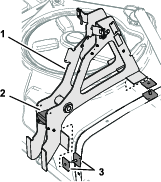
-
Remove and retain the 4 bolts and nuts securing the guide plate to the main-support-frame assembly (Figure 3).
-
Install the main support frame over the square spacers and carriage bolts as shown in Figure 3.
-
Check the fit of the main support frame to the tank.
When shimmed correctly, the feet of the main support frame are flush with the surface of the tank.
Important: If the main support frame is not flush, add or remove the installed thick and thin square spacers until the feet of the main support frame are flush with the surface of the tank.
-
Secure the main support frame to the tank strap (Figure 4) using 2 flange locknuts (3/8 inch).
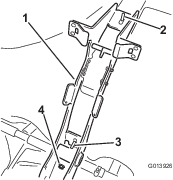
-
Install the previously removed guide plate with the 4 bolts and nuts retained in step 5.
Preparing the Cradle Arms
-
Assemble the pivot pin through the upper hole in the cradle arm (Figure 5).
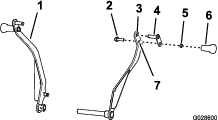
-
Apply medium-grade, thread-locking compound to the threads of the bolt (3/8 x 1-1/4 inch).
-
Assemble the bolt (3/8 x 1-1/4 inch) through the lower hole in the cradle arm and the retainer of the pivot pin (Figure 5) with the jam nut (3/8 inch), and tighten the jam nut to 15 to 17 N∙m (11 to 13 ft-lb).
-
Thread the handle onto the bolt (3/8 x 1-1/4 inch) and tighten the handle against the jam nut and tighten the handle by hand (Figure 5).
-
Repeat steps 1 through 4 to the other cradle arm (Figure 5).
Assembling the Cradle Arms to the Support Frame
-
Insert the axle of the right cradle arm through the hinge shaft (Figure 6).
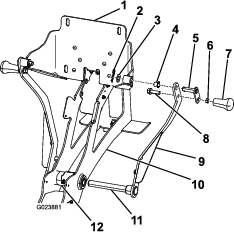
-
Loosely attach the left arm to the exposed axle on the other side of the frame. (Figure 6).
-
On the back-plate assembly, install the 2 small bushings into the back-plate pivot points (Figure 6).
-
Move the back-plate assembly into position between the upper holes in each arm. (Figure 6).
-
Install a pivot pin through the upper hole in the arm and the back-plate assembly. (Figure 6).
-
Secure the handle to the back-plate assembly using a flat washer and hairpin as shown in Figure 6.
-
Secure the handles to the lower holes on the arms (Figure 6) with a bolt (3/8 x 1-1/4 inches) and a jam nut (3/8 inch).
-
Secure the upper pivot pin of the left cradle arm to the back plate with a washer (1/2 inch) and hairpin (Figure 6).
-
Thread 2 set screws into the left arm at the lower hinge point (Figure 7).
Note: Do not tighten the set screws. You will tighten the set screws in Assembling the Eductor to the Sprayer.
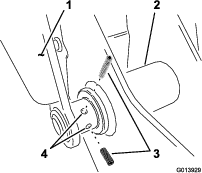
Installing the Latching Components
Parts needed for this procedure:
| Spring | 2 |
Installing the Springs
-
Install the spring in the hole in the lower end of the angled tab on the side of the frame assembly (Figure 8).
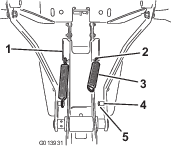
-
Hook 1 end of the spring into the hole and the other end onto the spring post (Figure 8).
-
Make sure that the spring end is seated properly in the groove in the post (Figure 8).
-
Repeat steps 1 through 3 for the other side.
Adjusting the Tongue Position
Move the cradle assembly into the upper transport position to adjust the tongue.
-
Lift the cradle handles to raise the assembly while slightly tipping it toward the tank.
-
Guide the tongue under the crossbar with the welded tab in the upper portion of the frame assembly.
-
Let the assembly pivot down, toward the tank.
-
Making sure that the plastic stops are in contact with the spring tabs, apply enough pressure against the back plate assembly of the cradle to compress the spring tabs midway (Figure 9).
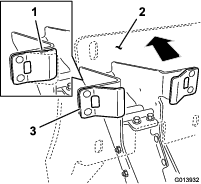
-
While maintaining the pressure on the back plate, slide the tongue toward you until the lip of the tongue plate contacts the crossbar (Figure 10).
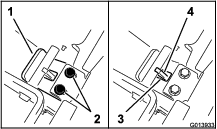
-
Tighten the fasteners in the tongue to secure its position, then release pressure on the back plate.
Note: Check to see if there is any play in the cradle. It should be held snug to the frame assembly. You can repeat this procedure once the eductor is installed to adjust the locked position.
Installing the Eductor
Parts needed for this procedure:
| Handle | 1 |
| Socket-head screw (#10-24 x 1/2 inch) | 2 |
| Latch post | 1 |
| Spring clip | 1 |
| Bolt (#10-24 x 1/2 inch) | 2 |
| Locknut (#10-24) | 2 |
| Eductor | 1 |
| Flange-head bolt (5/16 x 3/4 inch) | 2 |
| Flanged-locknut (5/16 inch) | 2 |
| Latch handle | 1 |
| Bolt (3/8 x 1 inch) | 4 |
| Flanged-serrated nut (3/8 inch) | 4 |
| T-fitting and drain valve | 1 |
| Gasket | 1 |
| Flange clamp | 1 |
Assembling the Eductor Handle
Note: You can install the latch handle and latch post at either the left or right side of the eductor handle.
-
Attach the handle to the eductor using 2 flange-head bolts and 2 flange nuts (Figure 11).
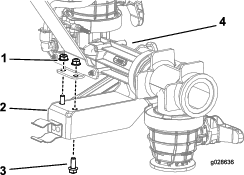
-
Lower the cradle into the down position.
Assembling the Eductor to the Sprayer
-
Align the holes in the eductor mount plate with the slots in the cradle support frame (Figure 12).
Note: The fasteners need to be loose enough so that they can travel in the slot when the eductor is initially raised up into the transport position. This allows you to adjust the travel and alignment of the eductor.
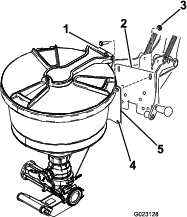
-
Assemble the eductor to the back plate (Figure 12) with the 4 bolts (3/8 x 1 inch) and locknuts (3/8 inch).
Note: Do not tighten the bolts and locknuts.
-
To carefully raise the eductor in the cradle assembly up to the transport position, do the following:
-
Lift the lower handle to raise the eductor while slightly tipping it toward the tank.
-
Guide the tongue under the crossbar with the welded tab in the upper portion of the frame assembly.
-
Then pivot the assembly toward the tank, taking care to line up the spring clip with the large pivot tube in the lower portion of the frame.
-
Push until the spring clip snaps over the pivot tube as shown in Figure 13.

-
-
Check the eductor height on the cradle back plate and adjust the eductor position as necessary.
-
Torque the bolts and locknuts securing the eductor to the to the back plate to 36 to 45 N∙m (27 to 33 ft-lb).
-
Tighten the 2 set screws on the left hand pivot arm, refer to Figure 7 in Assembling the Cradle Arms to the Support Frame.
-
Check the overall position of the eductor assembly on the sprayer tank strap.
Note: When adjusted correctly, the eductor appears upright when positioned to the transport position. Loosen the lower locknut on the frame assembly securing it to the tank. Do not remove the locknut. Adjust the position as necessary and tighten the locknut. Ensure that the tank strap is secure to the tank.
Installing the Eductor Hose
Parts needed for this procedure:
| Bulkhead | 1 |
| O-ring | 1 |
| Locking ring | 1 |
| Retainer pin | 2 |
| Eductor hose assembly | 1 |
| Supply hose assembly | 1 |
Drilling the Tank
-
Open the lid of the spray tank and remove the filter basket (Figure 14).
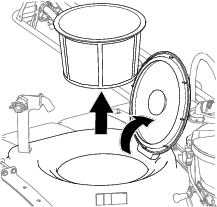
-
Locate the forward location on the top of the tank as shown in Figure 15.
Note: Locate the drill mark in the center of the molded circle.
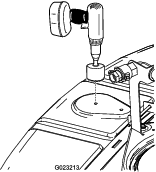
-
Use a 9 cm (3-5/8 inch) hole saw to drill a hole at the drill mark (Figure 15).
Note: You will need to increase the diameter slightly to accommodate the bulkhead.
-
After drilling the hole, remove any rough edges in the cut, and remove any debris that entered the main tank during the cutting process.
Installing the Bulkhead
-
Install the bulkhead fitting and the seal through the hole that you created in Drilling the Tank, from inside the tank (Figure 16).
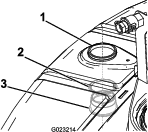
-
Secure the bulkhead to the tank with the locking ring (Figure 16).
-
Install the filter basket and close the lid of the spray tank.
Installing the Hoses
-
Install the hose end with the 90° fitting to the previously installed bulkhead using a retainer pin (Figure 17).
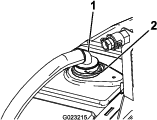
-
Attach the other end of the hose to the forward-facing opening of the eductor using a gasket and hose clamp (Figure 18).
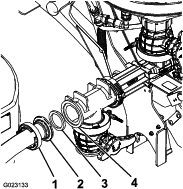
-
Raise and lower the eductor to ensure that the hose does not catch on anything.
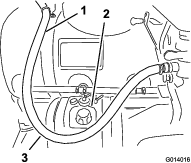
-
Secure the end of the supply hose without a bulkhead to the rear opening on the eductor valve using the gasket and hose clamp (Figure 20).
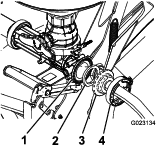
Installing the Eductor Valve Assembly
Parts needed for this procedure:
| Retainer pin | 2 |
| Valve bracket | 1 |
| Eductor valve | 1 |
| Pressure hose assembly | 1 |
Connecting the Valve Assembly
-
Remove the elbow, flange clamp, gasket, elbow, and inlet hose from the pressure filter head (Box A of Figure 21).
Note: Retain the gasket, flange clamp, and retainer pin for installation later.
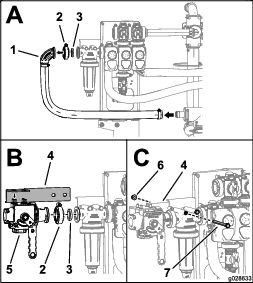
-
Place the valve bracket on top of the eductor valve as shown in Box B of Figure 21.
-
Install the eductor valve using the gasket and flange clamp removed in Step 1; refer to Box B of Figure 21.
-
Secure the bracket to the boom valve assembly using the bolts and nuts that are currently installed on the pressure filter; refer to Box C of Figure 21.
-
Route and secure the pressure hose assembly as shown in Figure 22.
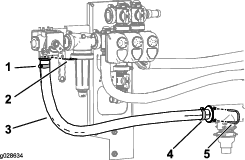
-
Secure the supply hose to the valve using a retainer pin.
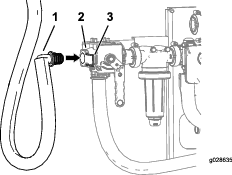
Finishing the Installation
Parts needed for this procedure:
| Suction lance and hose (optional accessory) | 1 |
Note: The suction lance and hose are optional accessories. Contact your authorized Toro distributor for more information.
Retain the suction lance and hose for later use. Read and retain the remaining documentation on using the Chemical Pre-Mix Kit.
Product Overview
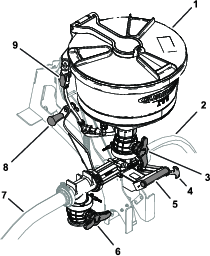
Lid
Rotate the lid (Figure 24) counter clockwise to open it. Close the lid completely before turning it clockwise to lock it. You must close the lid and lock it before it is raised to the transport position.
Hopper Valve
Use the hopper valve (Figure 24) to introduce chemicals from the hopper, into the eductor, and to the hose leading to the sprayer tank.
Handles and Transport Strap
Use the upper and lower handles (Figure 24) to raise and lower the eductor and to lock it into the transport position.
Drain Valve
Open the drain valve when cleaning the eductor tank. Close the drain valve when operating the eductor.
Rinse Valve
The rinse valve can rinse the inside of the eductor tank. Once the eductor switch is on, the rinse valve will have pressure and is supplied by the contents of the sprayer tank. To open the valve, turn the handle (Figure 24) 90° counterclockwise. This will in introduce fluid into the tank. Turn the handle 90° clockwise to close the valve.
Bottle Rinse
The bottle rinse is located inside the eductor tank (Figure 25). Once the eductor switch is on, the bottle rinse has pressure and is supplied by the content of the sprayer tank. To use the bottle rinse, invert the chemical container over the spout and use the rim of the container to depress the rinse. Press down to actuate the spout and rinse the interior of the chemical container.
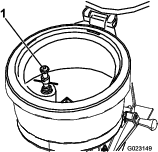
Eductor Valve
Use the eductor valve to control sprayer system flow to the eductor circuit (Figure 26).
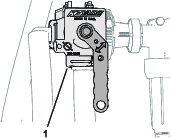
Operation
Before Operation
Caution
Chemicals are hazardous and can cause personal injury.
-
Read the directions on the chemical labels before handling the chemicals and follow all manufacturer recommendations and precautions.
-
Keep chemicals away from your skin. Should contact occur, wash the affected area thoroughly with soap and clean water.
-
Wear goggles and any other protective equipment recommended by the chemical manufacturer.
During Operation
Raising and Lowering the Eductor
Lowering the Eductor
-
Unlatch the rubber transport strap.
-
Place one hand on the lower handle and the other hand on the upper handle.
-
Lift the eductor away from the vehicle until the spring clamp disengages.
-
Guide the eductor as it lowers to the operation position.
Raising the Eductor
-
Lift the lower handle to raise the eductor while slightly tipping it toward the tank.
-
Guide the tongue under the cross bar with the welded tab in the upper portion of the frame assembly.
-
Pivot the assembly toward the tank, taking care to line up the spring clamp with the large pivot housing in the lower portion of the frame.
-
Push until the clamp snaps over the pivot housing.
-
Secure the handle with the transport strap.
Protecting the Turf when Operating a Stationary Machine
Important: Under some conditions, heat from the engine, radiator, and muffler can potentially damage the grass when operating the sprayer in a stationary mode. Stationary modes include tank mixing, agitation, hand spraying, or using a walking boom.
Take the following precautions:
-
Avoid stationary spraying when conditions are very hot and/or dry, as turf can be more stressed during these periods.
-
Avoid parking the machine on the turf while stationary spraying. Park the machine on a cart path whenever possible.
-
Minimize the amount of time that the machine is left running over any particular area of turf. Both time and temperature affect how much the grass may be damaged.
-
Set the engine speed as low as possible to achieve the desired pressure and flow. This will minimize the heat generated and the air velocity from the cooling fan.
Note: Use a heat shield blanket underneath the vehicle during stationary operation for additional heat protection. Contact your authorized Toro distributor to obtain a Toro heat shield blanket kit for turf sprayers.
Using the Eductor
The following procedure assumes the following operational states exist for the standard tank agitation: the sprayer is started and running, the pump is engaged and set to the desired pressure, and the throttle is in the mid-range position.
Starting the Eductor
-
Close the eductor valve, hopper valve, rinse valve, and drain valve before starting the eductor.
-
Lower the eductor; refer to Lowering the Eductor.
-
Open the lid to check for foreign objects which may hinder performance or contaminate the system.
Clean the hopper as needed.
-
Close and lock the lid by turning it clockwise.
-
Rotate the eductor valve to open sprayer system flow to the eductor circuit.
-
Open the hopper valve (the red handle located at the bottom of the hopper).
-
Unlock and open the lid slowly by turning the cover counterclockwise.
Loading Liquid or Powdered Chemical into the Hopper
-
Pour the required amount of chemical into the hopper.
Note: Avoid splashing liquids or powdered chemicals outside of the hopper.
-
If applicable, rinse the empty chemical containers by placing the opening of the container over the spout of the bottle rinse, press the container down, and removing the container when it is clean.
Pressing down the spout activates the rinse valve and rinses the container.
-
Close and lock the lid by turning it clockwise.
-
Open the rinse valve and rinse the hopper for 20 seconds.
-
Close the rinse valve.
-
Open the lid and inspect the hopper for chemical residue.
Note: Repeat steps 3 through 6 until the chemical residue is flushed from the hopper.
-
Close the eductor valve, hopper valve, rinse valve, and drain valve.
-
Raise the eductor to the transport position and secure it with the transport strap; refer to Raising the Eductor.
Loading Chemicals with the Suction Lance (Optional Accessory)
Note: Lance suction depends upon eductor pressure and flow. For best results, use pressure up to 150 psi maximum.
-
Insert the suction lance body into the eductor until the O-ring seals on the hopper drain.
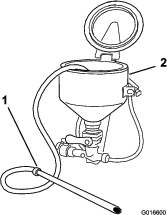
-
Use the free end of the lance to pierce the bag or container to vacuum powdered or liquid chemical.
-
Place the lance end into a clean container of water to rinse the lance assembly.
-
Remove the lance body from the eductor and drain any remaining fluid into the hopper.
-
Close the hopper valve (red handle).
Shutting Down the Eductor
-
Close and lock the hopper lid by turning the cover clockwise.
-
Align a 19 L (5 US gallon) container under the drain valve.
-
Open the drain valve.
-
Allow the eductor to fully drain and close the valve.
-
Raise the eductor to the transport position and secure it with the transport strap; refer to Raising the Eductor.
Operating Tips
Perform the following steps if you are having difficulty getting the powered or granulated chemicals to mix in the sprayer tank:
-
Mix a portion the chemical into the sprayer tank.
-
Close the eductor valve and run sprayer tank agitation.
-
Open the eductor valve and mix another portion of the chemical into the sprayer tank.
-
Repeat steps 2 and 3 until all the chemicals are mixed into the sprayer tank.
After Operation
Cleaning Eductor
Important: Do not use brackish or reclaimed water to clean the machine.
-
Prepare the sprayer system for cleaning; refer to the Cleaning the Sprayer System in the Operator’s Manual for your machine.
-
Lower the eductor and ensure that the lid is closed and locked; refer to Lowering the Eductor.
-
Open the eductor valve, hopper valve, and rinse valve.
-
Clean the sprayer system; refer to the Cleaning the Sprayer System in the Operator’s Manual for your machine.
-
Close the rinse valve, hopper valve, and eductor valve.
-
Align a 19 L (5 US gallon) container under the drain valve, open the drain valve, allow the eductor to fully drain, and close the valve.
-
Close and lock the hopper lid by turning the cover clockwise.
-
Wash the exterior of the eductor as needed using water alone or with a mild detergent.
-
Raise the eductor to the transport position and secure it with the transport strap; refer to Raising the Eductor.
Troubleshooting
| Problem | Possible Cause | Corrective Action |
|---|---|---|
| The eduction rate is low. |
|
|
| There is no rinsing or flushing action. |
|
|
| There are leaks at the fittings. |
|
|